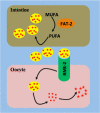New insights into the mechanism of fertilization in nematodes
- PMID: 21749902
- PMCID: PMC3273857
- DOI: 10.1016/B978-0-12-386039-2.00006-7
New insights into the mechanism of fertilization in nematodes
Abstract
Fertilization results from the fusion of male and female gametes in all sexually reproducing organisms. Much of nematode fertility work was focused on Caenorhabditis elegans and Ascaris suum. The C. elegans hermaphrodite produces a limited number of sperm initially and then commits to the exclusive production of oocytes. The postmeiotic differentiation called spermiogenesis converts sessile spermatids into motile spermatozoa. The motility of spermatozoa depends on dynamic assembly and disassembly of a major sperm protein-based cytoskeleton uniquely found in nematodes. Both self-derived and male-derived spermatozoa are stored in spermatheca, the site of fertilization in hermaphrodites. The oocyte is arrested in meiotic prophase I until a sperm-derived signal relieves the inhibition allowing the meiotic maturation to occur. Oocyte undergoes meiotic maturation, enters into spermatheca, gets fertilized, completes meiosis, and exits into uterus as a zygote. This review focuses on our current understanding of the events around fertilization in nematodes.
Copyright © 2011 Elsevier Inc. All rights reserved.
Figures




Similar articles
-
Control of oocyte meiotic maturation and fertilization.WormBook. 2005 Dec 28:1-12. doi: 10.1895/wormbook.1.53.1. WormBook. 2005. PMID: 18050412 Free PMC article. Review.
-
Measuring Sperm Guidance and Motility within the Caenorhabditis elegans Hermaphrodite Reproductive Tract.J Vis Exp. 2019 Jun 6;(148):10.3791/59783. doi: 10.3791/59783. J Vis Exp. 2019. PMID: 31233026 Free PMC article.
-
The role of gap junctions in Caenorhabditis elegans oocyte maturation and fertilization.Dev Biol. 2007 Jan 15;301(2):432-46. doi: 10.1016/j.ydbio.2006.08.038. Epub 2006 Aug 22. Dev Biol. 2007. PMID: 16982048
-
An Eph receptor sperm-sensing control mechanism for oocyte meiotic maturation in Caenorhabditis elegans.Genes Dev. 2003 Jan 15;17(2):187-200. doi: 10.1101/gad.1028303. Genes Dev. 2003. PMID: 12533508 Free PMC article.
-
[Recent advances in the study of spermatogenesis and fertilization in Caenorhabditis elegans].Yi Chuan. 2008 Jun;30(6):677-86. doi: 10.3724/sp.j.1005.2008.00677. Yi Chuan. 2008. PMID: 18550488 Review. Chinese.
Cited by
-
Sex Matters: Effects of Sex and Mating in the Presence and Absence of a Protective Microbe.Front Cell Infect Microbiol. 2021 Oct 7;11:713387. doi: 10.3389/fcimb.2021.713387. eCollection 2021. Front Cell Infect Microbiol. 2021. PMID: 34692559 Free PMC article.
-
Tension-dependent RHGF-1 recruitment to stress fibers drives robust spermathecal tissue contraction.J Cell Biol. 2023 Feb 6;222(2):e202203105. doi: 10.1083/jcb.202203105. Epub 2022 Dec 27. J Cell Biol. 2023. PMID: 36574264 Free PMC article.
-
Programmed DNA elimination in the parasitic nematode Ascaris.PLoS Pathog. 2023 Feb 2;19(2):e1011087. doi: 10.1371/journal.ppat.1011087. eCollection 2023 Feb. PLoS Pathog. 2023. PMID: 36730159 Free PMC article. Review.
-
An RNAi-based suppressor screen identifies interactors of the Myt1 ortholog of Caenorhabditis elegans.G3 (Bethesda). 2014 Oct 8;4(12):2329-43. doi: 10.1534/g3.114.013649. G3 (Bethesda). 2014. PMID: 25298536 Free PMC article.
-
C. elegans spermatozoa lacking spe-45 are incapable of fusing with the oocyte plasma membrane.MicroPubl Biol. 2021 Feb 21;2021:10.17912/micropub.biology.000372. doi: 10.17912/micropub.biology.000372. MicroPubl Biol. 2021. PMID: 33644705 Free PMC article.
References
-
- Abbas M, Cain GD. In vitro activation and behavior of the ameboid sperm of Ascaris suum (Nematoda) Cell Tissue Res. 1979;200:273–84. - PubMed
-
- Baker AM, Roberts TM, Stewart M. 2.6 A resolution crystal structure of helices of the motile major sperm protein (MSP) of Caenorhabditis elegans. J Mol Biol. 2002;319:491–9. - PubMed
-
- Brattig NW, Schwohl A, Rickert R, Buttner DW. The filarial parasite Onchocerca volvulus generates the lipid mediator prostaglandin E(2) Microbes Infect. 2006;8:873–9. - PubMed
Publication types
MeSH terms
Grants and funding
LinkOut - more resources
Full Text Sources

